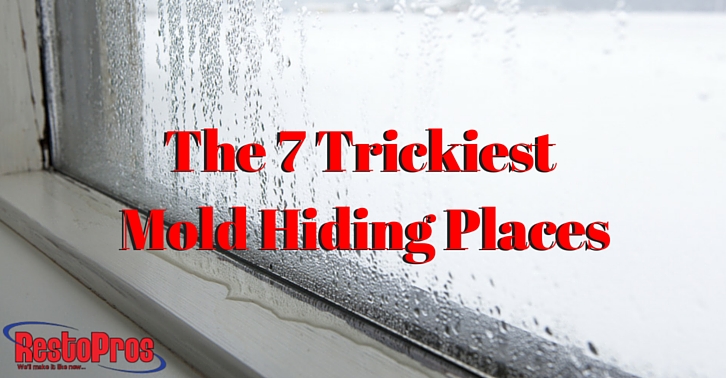 Mold can grow anywhere, provided it finds three things: a comfortable climate, a surface, and a food supply. Most things are a food supply to mold and most things have multiple surfaces. So the last thing it needs is the right combination of humidity and temperature to grow unimpeded. As soon as the climate matches, mold spores (which are everywhere) immediately begin to grow and reproduce, spreading across a surface and slowly eroding it away.
Mold can grow anywhere, provided it finds three things: a comfortable climate, a surface, and a food supply. Most things are a food supply to mold and most things have multiple surfaces. So the last thing it needs is the right combination of humidity and temperature to grow unimpeded. As soon as the climate matches, mold spores (which are everywhere) immediately begin to grow and reproduce, spreading across a surface and slowly eroding it away.
You know to check the problem locations: the utility closet, the bathroom, and the basement. But there are other places where mold is not only surprisingly common, but often grows unchecked. After storms, humid days, damaged plumbing, or even just once a month you should do a quick inspection of all these special hiding places to make sure you don’t have secret mold hiding away.
Chimneys
Brick crevices and molding give plenty of places for water and dirt to accumulate. The inside of your chimney is also protected from harmful UV rays, which can kill off mold. When chimney caps and damaged flashing allow water and moisture into the chimney, it creates a perfect breeding ground for mold. Unfortunately, due to how difficult (and dangerous) it is to clean a chimney, your best option is to hire a professional mold cleaner (or get regular chimney sweeps).
Windowsills and under Sink Cabinets
Overhangs that are protected from direct sunlight but are still close to condensation spots or water leaks make great places for mold. Sink cabinets (where a single drip from a leaky pipe can raise humidity) or around windowsills (where moisture can arise from the window condensation or from small leaks) make great places for mold to hide out.
The best thing you can do is clean up after storms or after you find a leak. When a storm is through, open the windows and wipe away excess water and moisture.
On Dishes
Wet dishes drying on a rack are fine, but placing damp or wet dishes in cabinets (or leaving them sitting the dishwasher) will provide extremely humid and warm environments for mold to grow on the surface of dishes. Fortunately, this can become obvious pretty quickly when you grab a dish and find spots on it. But if you’ve left them sitting in the dishwasher it’s best if you give the dishwasher a thorough cleaning before putting any more dishes through.
Washing Machines
Anywhere you find water, there’s risk of mold. So of course your cleaning appliances are at risk. This includes your washing machine and clothes dryer. For front loading machines, check the seals around the door for accumulated moisture and leave them open to dry after you run a load of clothes through. Check the detergent chamber of your washing machine as well, since water can pool inside it start mold growth. Mold here is especially damaging since it will eat through clothing over time.
HVAC Drain Pans
Your HVAC and Furnace are both going to generate a lot of water in the form of condensation. Check the drain pans and drip lines, not to mention the areas around your HVAC unit for signs of mold growth or water spills.
Carpets and Carpet Mats
If there’s been a water spill in any room with a carpet, then you need to keep careful watch on that room for a few weeks. The matting underneath your carpet will absorb and hold onto water, sometimes staying damp for far longer than the carpet above. Whenever there is a major spill, use a wet-vac to try and remove as much water from it as possible. Adding a desiccant or running an air conditioner to dry out the air will help as well.
Mold thrives especially well underneath the carpet and can stay hidden for months before anyone is the wiser. With every step on the carpet, mold spores are spread into the air, leaving you with aggravated allergies and a higher chance of mold growth elsewhere.
If you find mold growing under your carpet, it may be time to call a professional. If it’s a large infestation, then you need mold remediation immediately. In either circumstance, replacing the matting is probably going to be necessary.
Inside Walls
Usually this one is hard to spot. Plumbing drips, leaky roofs, and general flooding all have the chance to spur mold growth inside the walls of your home. The easiest way to identify this will be in water stains on walls and ceilings. Unfortunately, it’s too late to do much else but call for remediation by this point. Performing regular leak detection for plumbing and roofs will go a long way toward preventing this unfortunate case.
Don’t forget to follow RestoPros on Facebook, Twitter, LinkedIn, and Google+ for new Updates, News, and Discounts!
